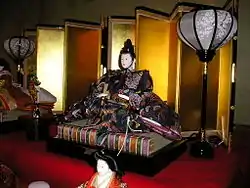人形
Japanese

Etymology 1
| Kanji in this term | |
|---|---|
| 人 | 形 |
| にん Grade: 1 |
ぎょう Grade: 2 |
| on’yomi | |
From Middle Chinese compound 人形 (nyin heng, literally “person shape”).
Noun
人形 (hiragana にんぎょう, rōmaji ningyō, historical hiragana にんぎやう)
- doll, puppet
- a picture of someone's appearance
- a figurative puppet, such as someone who carries out actions for someone else
- (less common) a tailor's dummy, a mannequin
Usage notes
For the general sense of doll, the ningyō reading appears to be more common.
Etymology 2
| Kanji in this term | |
|---|---|
| 人 | 形 |
| ひと Grade: 1 |
かた > がた Grade: 2 |
| kun’yomi | |
Compound of 人 (hito, “person”) + 形 (kata, “shape, form”). The kata changes to gata as an instance of rendaku (連濁).
Alternative forms
- 人像 (less common)
Noun
人形 (hiragana ひとがた, rōmaji hitogata)
- a human shape
- a doll
- a tailor's dummy, a mannequin
- a proxy, a representative
- a person's appearance
- a description or sketch of a person, as in a wanted poster created by the police
This article is issued from Wiktionary. The text is licensed under Creative Commons - Attribution - Sharealike. Additional terms may apply for the media files.